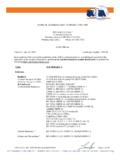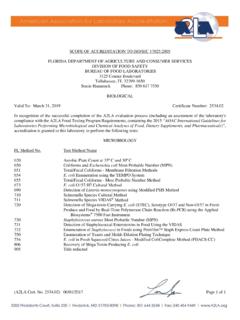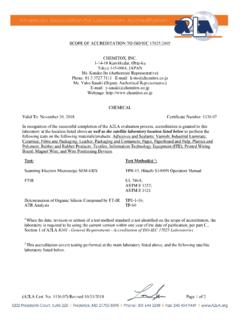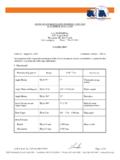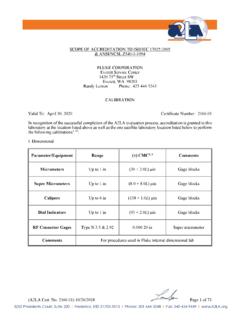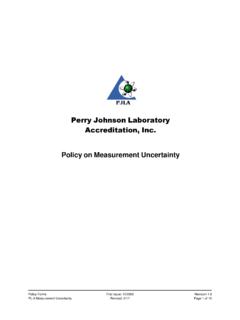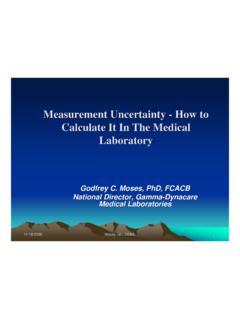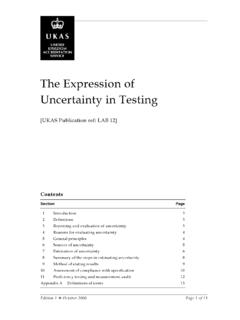Transcription of P103 - Policy on Estimating Measurement Uncertainty for ...
1 A2LA P103 Policy on Estimating Measurement Uncertainty for Testing Laboratories Document Revised: 3/5/18 Page 1 of 5 L:\Requirements\P103 Policy on Estimating Measurement Uncertainty for Testing Laboratories INTRODUCTION The concept of Estimating Measurement Uncertainty for testing remains a contested area for both the laboratory testing community and their customers. A2LA continues its practical approach to implementing the ISO/IEC 17025 and ISO 15189 Measurement Uncertainty requirements for applicant testing laboratories that should allow a new laboratory to address these requirements in a reasonable manner. This Policy is applicable to all laboratories undergoing initial or renewal A2LA assessments.
2 Additional requirements, including examples of methods that fit the categories (I-V) listed below, can be found in the Annexes to this Policy , which are found as separate documents on the A2LA web site. Assessors shall use the information provided in the relevant Annexes when determining the Measurement Uncertainty categories for a laboratory s scope of accreditation. P103a - Annex - Policy on Measurement Uncertainty for Automotive and Materials Testing Laboratories. P103b - Annex - Policy on Measurement Uncertainty for Life Sciences Testing Laboratories. P103c - Annex - Policy on Measurement Uncertainty for Electromagnetic Testing Laboratories. P103d - Annex - Policy on Measurement Uncertainty for Construction Materials and Geotechnical Testing Laboratories.
3 P103e Annex - Policy Measurement Uncertainty for Forensic Conformity Assessment Bodies. P703 - Policy on Estimating Uncertainty of Measurement for CLIA-ISO 15189 Testing Labs P903 - Policy on Estimating Uncertainty of Measurement for ISO 15189 Testing Labs A2LA also offers discipline-specific annexes for determining Measurement Uncertainty estimations for specific testing categories: life sciences; (automotive) materials; construction materials, electromagnetic compatibility, medical, and forensic. These documents have been developed and reviewed by A2LA s technical advisory committees. The information offered in these annexes is available on the A2LA website ( ).
4 Links to additional, external guidance documents are also included. It is suggested that our website be checked frequently, since further guidance documents will be made available as information is collected. A2LA P103 Policy on Estimating Measurement Uncertainty for Testing Laboratories Document Revised: 3/5/18 Page 2 of 5 L:\Requirements\P103 Policy on Estimating Measurement Uncertainty for Testing Laboratories A2LA has defined the following Measurement Uncertainty category (I-V below) for the tests identified on the laboratory's proposed scope of accreditation: I. Qualitative or semi-quantitative tests for which Measurement Uncertainty budgets will not be required. II.
5 Well-recognized test methods that specify limits to the values of the major sources of Uncertainty of Measurement and specify the form of presentation of calculated results. In such cases, the laboratory is considered to have satisfied this clause by following the test method and reporting instructions. III. Chemical, environmental, or biological test methods based on published regulatory or consensus methods (examples: FDA, EPA, AOAC, ASTM, APHA/AWWA, USDA/FSIS) for which the Measurement Uncertainty is not defined in the method. For these types of tests, Uncertainty estimates are required and can be determined using appropriate, published guidance documents such as the ISO Guide to the Expression of Uncertainty in Measurement , CITAC Guide 1, ISO 5725, CLSI: C51- Expression of Measurement Uncertainty in Laboratory Medicine, etc.
6 Also, there may be test methods that have no significant sources of Uncertainty other than random error and when this is the case, determining the random error (usually per ISO/IEC 17025:2005, section or ISO/IEC 17025:2017 section or ISO 15189, section ) satisfies the requirement for Uncertainty estimation. IV. Test methods that need identification of the major components of Uncertainty and a reasonable estimate of Measurement Uncertainty . V. Test methods that need identification of all components of Uncertainty and detailed Measurement Uncertainty budgets calculated in accordance with published methods that are consistent with those described in the Guide to the expression of Uncertainty in Measurement Evaluation of Measurement data Guide to the expression of Uncertainty in Measurement .
7 Please note that the categories for Measurement Uncertainty estimations as defined in each of the discipline-specific annexes for determining Measurement Uncertainty estimations takes precedence over the categories as defined in this document. The categories as defined here would apply only when the annexes categories do not adequately address the Measurement Uncertainty needs for the particular test. Laboratory-developed methods require validation per ISO/IEC 17025:2005, section or ISO/IEC 17025:2017, section , ISO 15189, section , or , whichever is applicable. As part of this validation, the significance of the Measurement components, or the significance of the modifications of the Measurement components from the standard test method, must be considered so that the appropriate Measurement Uncertainty category for the laboratory- developed method can be identified.
8 A2LA P103 Policy on Estimating Measurement Uncertainty for Testing Laboratories Document Revised: 3/5/18 Page 3 of 5 L:\Requirements\P103 Policy on Estimating Measurement Uncertainty for Testing Laboratories Note that in order to determine if the Uncertainty affects compliance to a specification limit (ISO/IEC 17025:2005,section or ISO/IEC 17025:2017, section ), or when interpreting measured quantity values ISO 15189, ) Uncertainty must be estimated. PROCEDURE 1) Prior to scheduling the initial assessment for an applicant laboratory and as part of the document review, the assessor(s) will review the draft scope(s) of accreditation, and determine the test methods that require the estimation of Uncertainty in accordance with the categories III, IV and V above.
9 2) The assessor will then choose a sampling from these test methods. The size of the scope(s), and the distribution of categories across the full scope(s) will be taken into consideration when choosing the sample. The technical assessors will also have a good understanding of those test methods where there are special considerations or challenges in developing Measurement Uncertainty budgets and will include those in the sampling as well. By the same token, similar testing methods for a given technology may share the same budget. The assessor will require that Measurement Uncertainty budgets for 15% of the relevant tests be generated prior to the assessment.
10 In those limited cases where A2LA includes the best Measurement Uncertainty on the scope of accreditation for testing ( dimensional testing) generation of Uncertainty budgets for all of the tests on the scope is required before accreditation can be granted. 3) During the assessment the assessor will confirm the presence of a written procedure for applying Measurement Uncertainty estimations (required for ISO 15189 only). There must also be personnel knowledgeable in Estimating Measurement Uncertainty for the full scope(s) of accreditation. The knowledgeable person(s) who develops the Uncertainty budgets, software and so forth may be an employee of the larger organization or some other outside source.
